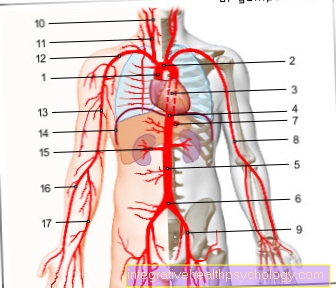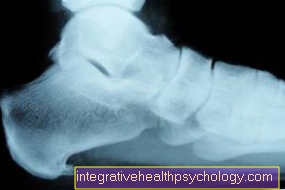Headache behind the eye

What is a headache behind the eye?
Headaches that appear behind the eye can be very painful and a major burden for those affected. Especially if the pain occurs very frequently or if the pain is very severe, a doctor should be presented in order to exclude possible serious illnesses and to avoid their effects.
Depending on the cause, the headache can be accompanied by various other symptoms, such as a common cold, visual disturbances or an excessively watery eye.
Read more on the subject under: Back of the headache
The possible causes
The possible causes that lead to headaches behind the eye are very diverse. For example, in addition to banal frontal headaches and a migraine, a sinus infection can also be the cause, which is usually associated with a runny nose and a feeling of pressure that becomes significantly stronger when bending forward.
There are also special forms of headache that almost always occur at this location and cause very severe pain, the so-called cluster headaches.
The unbearable pain is often described as a "pinprick in the eye" and lasts 15 to 180 minutes.
They are accompanied by a watery, reddened eye, as well as increased sweating, a drooping eyelid and general restlessness. Another possible cause is acute glaucoma (glaucoma).
This often leads to an increase in pressure in the eye, which leads to damage to the optic nerve and thus causes pain. The inflammation of a certain vessel in the area of the temples, the so-called temporal arteritis, can in certain cases lead to headaches that can be perceived behind the eye.
It is often accompanied by a visual impairment, which can persist without immediate therapy.
Read more on the subject at:
- Glaucoma - glaucoma
- Cluster headache
- Temporal arteritis
Cause cervical spine
Neck pain and headache often occur together, which is due to the functional interconnection of the cranial nerves.
These are interconnected in such a way that the brain cannot differentiate whether the pain is coming from the neck or the head. Thus headaches can lead to neck pain and vice versa.
Tension or blockages in the cervical spine are commonly referred to as cervical spine syndrome.
This is considered to be one of the main causes of tension headaches, which can also radiate into the eyes.
Sinus infection
Inflammation of the paranasal sinuses is not a rare condition and occurs mainly in the winter months.
It differs from a common cold in that it involves the sinuses that are below and above the eyes.
In addition to the symptoms of a cold, it presents itself primarily with persistent tenderness over the sinuses, which becomes significantly stronger when bending forward. Not infrequently, this persistent pressure pain leads to the development of headaches, which can be perceived through the narrow anatomical position behind the eye.
The therapy of sinusitis consists in the use of decongestant nasal sprays, which, depending on the preparation, contain cortisone and must be used for 2 weeks in order to achieve complete healing.
Read more about this under: Sinusitis (sinus infection)
diagnosis
As is so often the case, just taking a medical history can be instrumental in diagnosing a headache behind the eye.
For example, if the person concerned reports of an accompanying cold with tenderness, the diagnosis of sinusitis is obvious.
However, if the underlying cause is not clear, a more detailed diagnosis of the headache should be carried out. In addition to the exact description of the localization, the intensity and ancillary complaints, this usually consists of drawing up a headache diary.
This can be crucial in diagnostics, as many types of headache have a characteristic pain progression. In rare cases, imaging may be necessary to exclude diseases such as temporal arteritis. You should also see an ophthalmologist in order to rule out diseases such as glaucoma.
Concomitant symptoms
Depending on the underlying cause, various accompanying symptoms can occur with a headache behind the eye.
In addition to the feeling of pressure in the case of inflammation of the sinus infection, for example a red, watery eye is an indication of the presence of cluster headaches.
Nausea, vomiting and sensitivity to light, on the other hand, are often part of the accompanying symptoms of migraine attacks, which can also have the pain focus behind the eye. Migraines and other diseases such as acute glaucoma or temporal arteritis have in common that they can often be associated with short-term impairment or the total loss of vision in one eye.
If this symptom is not already known from other migraine attacks, a quick visit to a doctor should always take place in order to prevent possible permanent damage.
Read more on the subject under: Migraine attacks
nausea
The common occurrence of nausea with severe headaches is always suspicious for the presence of a migraine, which is usually associated with sensitivity to light and noise.
In addition to pain relievers, the therapy of migraine attacks often also includes preparations against nausea such as Vomex or MCP, which should be taken before the pain relievers.
In addition to nausea, however, other diseases can also lead to this combination of symptoms. In addition to the flu, which is mainly characterized by the additional fever and a severe feeling of illness, acute glaucoma (glaucoma) can also lead to headaches and nausea.
This clinical picture requires an immediate presentation to the doctor, as otherwise the optic nerve can be permanently damaged.
Read more on the subject under: Headache with nausea
Treatment and therapy
Before starting a specific treatment, a diagnosis should always be carried out so that a therapy adapted to the clinical picture can be carried out.
For example, the treatment of sinusitis consists of taking mild pain relievers such as ibuprofen and the use of decongestant nasal sprays, whereas migraines are treated with stronger, specific pain relievers from the group of triptans.
In addition, therapy for the accompanying nausea is usually necessary. If the headache is related to tension in the cervical spine and the surrounding musculature, the focus of the therapy should primarily be on performing physiotherapy.
Cluster headaches, which are accompanied by devastating pain, are often difficult and should be guided by a specialist. Here too, triptans are used in acute therapy, but these are supplemented by breathing in oxygen.
However, the former are usually injected into the subcutaneous fat or administered as a nasal spray in order to achieve a faster onset of action.
The treatment of acute glaucoma, which is accompanied by an increase in pressure in the eyeball, is treated either with hypotensive eye drops and, if necessary, also with intravenous administration.
In a few cases it is even necessary to create a small hole in the iris using a laser in order to achieve the required pressure relief.
Inflammation of the temporal artery (temporal arteritis) is part of the rheumatic type and is therefore treated with high-dose cortisone.
Read more on the topic at: Cervical Myelopathy
Duration
The duration of the headache also depends on the underlying cause.
For example, cluster headaches only last up to 3 hours, whereas a migraine can last up to 3 days.
Both diseases are inherent in that they occur more frequently. The frequency and trigger are individually very different.
Headache caused by sinus infection usually lasts until the decongestant effect of the nasal spray has set in, which can take three to four days.
The symptoms of acute glaucoma or temporal arteritis, however, usually disappear quickly as a result of adequate therapy.
forecast
The prognosis for headaches behind the eye is generally good in terms of a reduction in symptoms, as they are usually not based on any more serious illnesses.
A cure, however, is not possible for all possible causes, such as a migraine. Even if the symptoms of acute attacks can be alleviated by therapy, this is still only symptomatic therapy and the further occurrence of pain attacks is to be expected.
The prognosis of acute diseases such as acute glaucoma or inflammation of the temporal artery, on the other hand, depends largely on the time until the initiation of therapy.
With both diseases there is a risk of permanent damage to the optic nerve, which can lead to unilateral blindness or significant impairment of vision.
Can that be a brain tumor?
Even if a brain tumor cannot initially be clearly ruled out without performing an imaging procedure, its presence is, however, rather unlikely in most cases.
Such a tumor usually presents itself through its slowly progressive growth with long-lasting increasing symptoms, such as progressive poor eyesight.
Even if solid tumors are very rare in children, they have an increased risk of developing what is known as retinoblastoma.
This forms on the retina and almost always occurs in the fifth year of life.
However, the presence of such a tumor can be excluded with a simple examination under certain lighting conditions.
Read more about this under: Retinoblastoma





























